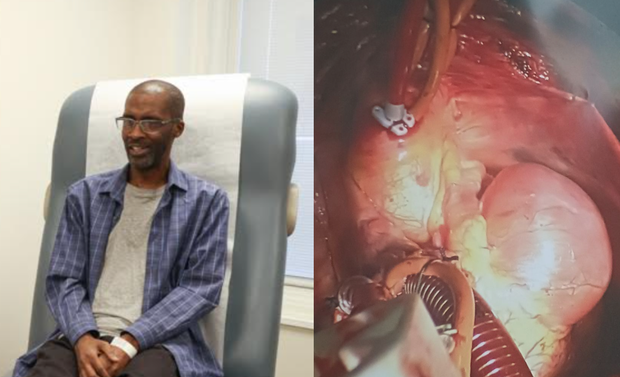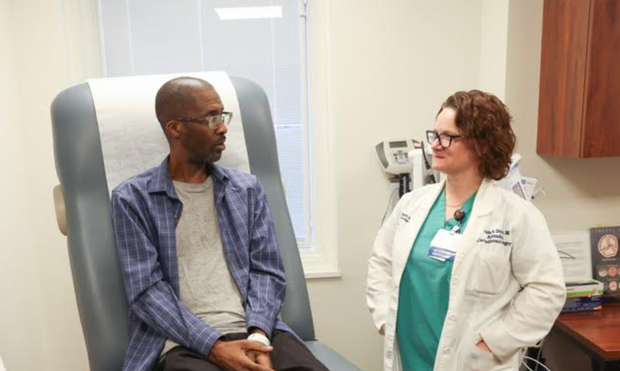Warren Donaldson didn't want to admit something was wrong.
The 64-year-old was experiencing shortness of breath, heart palpitations and brief dizzy spells. At first, he dismissed them. By January 2024, it had become difficult for him to go to the gym. In June, they had become so severe that he couldn't get through a casual game of basketball with his longtime teammates.
Then Donaldson saw another basketball player talk about similar symptoms. NBA legend Kareem Abdul-Jabbar in 2023 opened up about his diagnosis with atrial fibrillation, a form of heart arrhythmia that can increase the risk of strokes or other dangerous conditions. Donaldson had always admired Abdul-Jabbar — so when he saw the former NBA center participate in a public service campaign urging people to get their symptoms checked, he decided to visit his primary care physician. Donaldson's doctor saw a protruding vein in his neck and sent him to the emergency room.
Doctors at Newark Beth Israel Medical Center made a shocking discovery: There was a mass the size of an orange growing inside his heart.
"I couldn't believe I was carrying something that large in my chest," Donaldson said.
A "pretty impressive" diagnosisMasses like the one found in Donaldson's chest are known as pericardiac cysts. They are rare, occurring in about 1 in 100,000 people, and are usually found on the pericardium, the fluid-filled sac around the heart, said Dr. Shana Osho, a cardiac surgeon at Massachusetts General Hospital who was not involved in Donaldson's care. It's not clear why the cysts develop, Osho said, but most do not cause symptoms and are discovered by accident during other tests.
Most pericardiac cysts are just a few centimeters in size. Donaldson's "was pretty impressive," said Dr. Persida Drotar, a cardiothoracic surgeon at RWJBarnabas Health who treated Donaldson.
 Warren Donaldson and an image from his surgery, with the mass on the right.
Newark Beth Israel Medical Center
Warren Donaldson and an image from his surgery, with the mass on the right.
Newark Beth Israel Medical Center
Even more surprising than the size of the mass was its location. The cyst wasn't growing inside Donaldon's pericardium but in the muscle of his heart. That placement is incredibly rare, Osho said.
The cyst was pushing on Donaldson's right ventricular outflow tract, or RVOT, which carries blood from the heart's right ventricle to the pulmonary artery.
The left and right ventricles are supposed to contract at the same time with each heartbeat, sending blood from the right side of the heart to the lungs and blood from the left side of the heart to the rest of the body. The compression of Donaldson's right ventricular outflow tract meant blood couldn't get to his lungs. To compensate, his heart started beating faster, Drotar said, resulting in palpitations, dizziness and shortness of breath.
Removal and reconstructionOnce the mass had been identified, Drotar began developing a plan to treat it. Treatment for pericardiac cysts is usually minimally invasive, Osho said. Because of the size of Donaldson's cyst, Drotar had to use a more aggressive approach. She and the rest of Donaldson's care team made sure the rest of his heart was in healthy shape, then prepared for an open-heart procedure to remove the mass.
It took a week to complete the pre-operative exams, Drotar said. The waiting was terrifying, Donaldson said.
"The day before the operation, I was seriously considering signing myself out, which would have been foolish," Donaldson recalled. "My heartbeat started fluttering to like, 180, 190 beats a minute ... and they sent me to the ICU. So I guess that was God's way of saving 'You're not going anywhere.'"
When Donaldson was finally brought into surgery, Drotar found that the cyst was embedded within the wall of Donaldson's RVOT. That meant she couldn't just remove it. Instead, she and the rest of the surgical team had to put Donaldson on a heart-lung machine that could keep him alive while they stopped his heart. Then, they cut out the cyst and rebuilt his RVOT, Drotar said. The whole procedure took about five hours.
Returning to normalcy and feeling "great"Donaldson didn't learn about the extent of the procedure until he woke up. He said he was "overwhelmed with joy" when he was told everything had gone well, and that he would be able to resume his normal activities after a recovery period.
"You usually don't hear that in a lot of ailments," Donaldson said. "It gave me a lot of encouragement."
 Warren Donaldson and surgeon Dr. Persida Drotar.
Newark Beth Israel Medical Center
Warren Donaldson and surgeon Dr. Persida Drotar.
Newark Beth Israel Medical Center
Donaldson spent several days in the hospital, then underwent several weeks of cardiac rehab to rebuild his strength. He also met a cardiologist, whom he will see annually. Osho said pericardiac cysts don't tend to recur, but a patient will usually get an annual scan to monitor the heart.
Donaldson is now about three months out from the procedure. He bought a bicycle, something he said "wasn't even in (his) thoughts the last year or two" because of his symptoms. For the past few weeks, he's been walking between two and five miles each day. He is looking forward to resuming non-competitive basketball drills and said he hopes to rejoin his basketball team in the summer.
Donaldson said he's glad he saw the public service announcement from Abdul-Jabbar.
"I feel that if even just one person like Warren learns from my experience and takes their symptoms seriously ... it makes sharing my story worthwhile," Abdul-Jabbar told CBS News in a statement.
Donaldson said that if he hadn't felt encouraged to get checked out, he said, he'd likely still be dealing with the same symptoms.
"It made me feel comforted that he survived it. I thought, 'OK, once I confront it, hopefully I will have the same results.' Which I did," Donaldson said. "Now I feel great."
Kerry Breen




